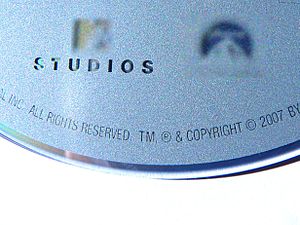- Copyright notice
-
A copyright notice, either as symbol or phrase, informs users of the underlying claim to copyright ownership in a published work.
Copyright law is different from country to country, and a copyright notice is required in about 20 countries for a work to be protected under copyright.[1] Before 1989 all published works in the US had to contain a copyright notice, the © symbol followed by the publication date and copyright owner's name, to be protected by copyright. This is no longer the case and use of a copyright notice is now optional in the US, though they may still be used as a deterrent against infringement, or as a notice that the owner intends on holding their claim to copyright.[2]
Contents
Technical requirements
 © is the copyright symbol
© is the copyright symbol
There are technical requirements as to the information a copyright notice must contain. In the US a copyright notice must contain the copyright symbol (a lower case letter c completely surrounded by a circle), or its equivalent in computer code. The word "copyright" or the abbreviation "Copr." are also accepted in the US, but not in other countries. Works distributed outside the US use the © symbol. The copyright notice must also contain the year in which the work was first published, and the name of the copyright owner, which may be the author, the legal owner of the work made for hire, or the person or entity to whom the copyright has been transferred. According to US Copyright Office regulations the copyright notice must not be concealed from an ordinary user's view.[1]
Overstatement of rights
Legal scholar Wendy Seltzer has pointed out how many organizations overstate their rights in the copyright notice. For her law class in 2007, Seltzer copied the televised copyright notice of the NFL, during the 2007 Superbowl, using her rights under fair use. She then posted this snippet to YouTube. The NFL sent an official DMCA request to YouTube that the recording be removed. Seltzer, who had expected this, challenged the takedown, and the snippet was restored.[3] Seltzer has also posted the overreaching claims of the Major League Baseball.[4]
See also
References
- ^ a b Fries, Richard C. (2006). Reliable design of medical devices. CRC Press. pp. 197. ISBN 0824723759, 9780824723750. http://www.google.com/books?id=nO0yEZmE3ZkC&dq=copyright+notices&lr=&as_brr=3&source=gbs_navlinks_s.
- ^ Fries, Richard C. (2006). Reliable design of medical devices. CRC Press. pp. 196. ISBN 0824723759, 9780824723750. http://www.google.com/books?id=nO0yEZmE3ZkC&dq=copyright+notices&lr=&as_brr=3&source=gbs_navlinks_s.
- ^ Wendy's Blog: Legal Tags - NFL/DMCA
- ^ Wendy's Blog: Legal Tags - Foul ball: Baseball’s copyright warnings
Categories:- Copyright law
- United States copyright law
Wikimedia Foundation. 2010.

